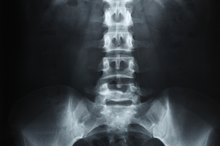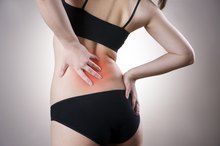Symptoms of a Pinched Nerve in the Upper Back
The backbone in your upper back is known as the upper thoracic spine. Multiple nerves enter and exit the spinal cord in this area. They can become compressed, or pinched, by a slipped disc or abnormalities of nearby ligaments or bones. Arthritis, an acute injury or chronic damage due to repetitive motions are common causes of nerve compression in the upper back. Less common causes include an infection or cancer involving the spine. Pinched nerves can produce pain or other symptoms.
If you are experiencing serious medical symptoms, seek emergency treatment immediately.
Pain
Pain is the most common symptom of a pinched nerve in the upper back, according to the “American Academy of Physical Medicine and Rehabilitation.” The pain is typically felt in the midline of the upper back, near the area where the nerve is pinched. But nerves from the spinal cord in the upper back travel into the inner part of the arms and front of the chest, so pain can be felt in these areas as well.
The pain typically feels sharp or burning and often worsens with coughing. **Pain from a pinched nerve in the upper back is sometimes confused with the pain caused by shingles, according to the “Weill Cornell Brain and Spine Center.**”
- Pain is the most common symptom of a pinched nerve in the upper back, according to the “American Academy of Physical Medicine and Rehabilitation.” Pain from a pinched nerve in the upper back is sometimes confused with the pain caused by shingles, according to the “Weill Cornell Brain and Spine Center.
- ”
Sensation Changes
Causes of Nerve Pain in the Hip & Leg
Learn More
Information about sensation in your skin travels through nerves to reach your spinal cord. From there, the information is eventually passed on to the brain. When these nerves are pinched, the information is blocked or altered, causing numbness, tingling or pins and needles sensations.
Nerves in the upper back carry information from the upper back, inner arms and chest, so numbness, tingling or pins and needles sensations occur in these areas. These are the same places where pain can be felt. Sensation changes and pain often occur simultaneously, but they may occur separately as well.
- Information about sensation in your skin travels through nerves to reach your spinal cord.
- When these nerves are pinched, the information is blocked or altered, causing numbness, tingling or pins and needles sensations.
Muscle Weakness
Other nerves transmit information from the brain and spinal cord to muscles, producing muscle movement. As some nerves in the upper back help control muscle movements in the hands, a pinched nerve in this area may produce weakness of the hand and fingers. But most pinched nerves in the upper back cause no obvious muscle weakness, which is one reason why pinched nerves in this area are often difficult to diagnose, according to an article published in the “Annals of Rehabilitation Medicine” in June 2016 5.
Warnings and Precautions
Causes of Pain in the Neck & Back of the Head
Learn More
See your doctor if you notice any symptoms of a pinched nerve in your upper back to determine the cause and begin appropriate treatment.
Seek immediate medical care if you also have symptoms in your legs -- such as sensation changes, weakness or paralysis -- or changes in bowel or bladder control. These symptoms suggest that the condition causing the pinched nerve may also be compressing your spinal cord. Spinal cord compression requires emergency medical care, often involving surgery.
Reviewed and revised by Mary D. Daley, M.D.
- See your doctor if you notice any symptoms of a pinched nerve in your upper back to determine the cause and begin appropriate treatment.
- Seek immediate medical care if you also have symptoms in your legs -- such as sensation changes, weakness or paralysis -- or changes in bowel or bladder control.
Related Articles
References
- Upsala Journal of Medical Sciences: Thoracic Radiculopathy Caused by Ossification of the Ligamentum Flavum
- Stat Pearls: Anatomy, Upper Limb, Muscles
- American Academy of Physical Medicine and Rehabilitation: Thoracic Radiculopathy/Myelopathy
- Weill Cornell Brain and Spine Center: Radiculopathy
- Annals of Rehabilitation Medicine: Thoracic Radiculopathy due to Rare Causes
- Hochman MG, Zilberfarb JL. Nerves in a pinch: imaging of nerve compression syndromes. Radiol Clin North Am. 2004;42(1):221-45. doi:10.1016/S0033-8389(03)00162-3
- NIH National Institute of Neurological Disorders and Stroke. Pinched nerve information page. Updated March 27, 2019.
- AdventHealth Medical Group. Cauda equina syndrome.
- AAOS OrthoInfo. Cervical radiculopathy (pinched nerve). Updated June 2015.
- Dimitrova A, Murchison C, Oken B. Acupuncture for the treatment of peripheral neuropathy: A systematic review and meta-analysis. J Altern Complement Med. 2017;23(3):164-179. doi:10.1089/acm.2016.0155
- Conger A, Cushman DM, Speckman RA, Burnham T, Teramoto M, McCormick ZL. The Effectiveness of Fluoroscopically Guided Cervical Transforaminal Epidural Steroid Injection for the Treatment of Radicular Pain; a Systematic Review and Meta-analysis. Pain Med. 2019 Jun 10. pii: pnz127. doi:10.1093/pm/pnz127 [Epub ahead of print]
- Keating L, Treanor C, Sugrue J, Meldrum D, Bolger C, Doody C. A randomised controlled trial of multimodal physiotherapy versus advice for recent onset, painful cervical radiculopathy - the PACeR trial protocol. BMC Musculoskelet Disord. 2019 Jun 1;20(1):265. doi:10.1186/s12891-019-2639-4
Writer Bio
Adam Cloe has been published in various scientific journals, including the "Journal of Biochemistry." He is currently a pathology resident at the University of Chicago. Cloe holds a Bachelor of Arts in biochemistry from Boston University, a M.D. from the University of Chicago and a Ph.D. in pathology from the University of Chicago.







